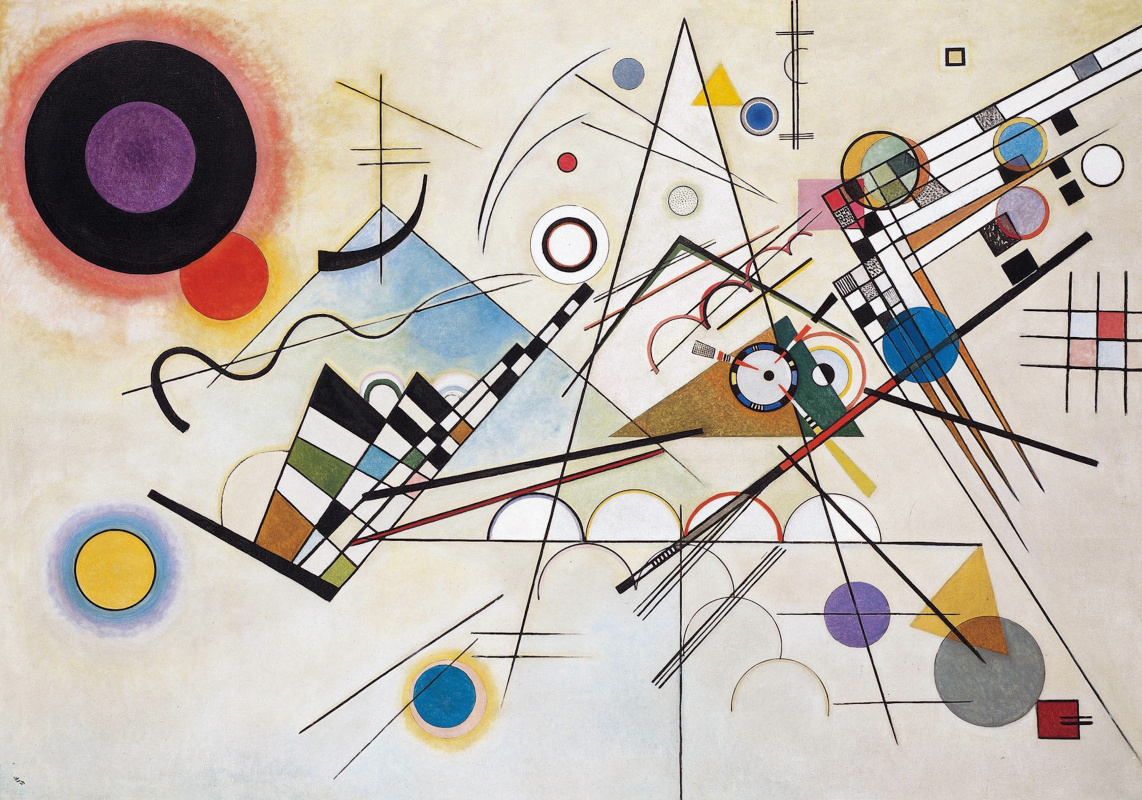log in
Enter site
Login to use Arthive functionality to the maximum
Composition VIII
Wassily Kandinsky • Painting, 1923, 140×201 cm
Description of the artwork «Composition VIII»
Kandinsky considered this painting one of the most important in his work, an accurate expression of his theory about the emotional properties of colour, line, shape. When completing the work, he taught in the Bauhaus and worked on his book “Point and Line to Plane”, which was published in 1926. 13 years have passed since he created his first nameless abstract watercolour.
“Composition VIII” was painted within the so-called “cold period”. The canvases of this period were marked by rigour, scientific logic, and contained the rational element. In this picture, the artist moved from colour to form; the latter created the composition and was the main character of the artwork.
His “Point and Line to Plane” treatise contains a detailed account of the psychological significance of each figure depicted. The horizontal lines sound “cold and minor”, the vertical lines are “warm and high”, the sharp corners are “warm, sharp, active and yellow”, and the straight lines are “cold, restrained and red”.
The artist understood all the difficulties that an unprepared viewer could encounter, and said that this picture required a different approach to watch: you must first examine it closely, then relax your eyes and allow what you see to penetrate the part of the brain that responds to music.
Despite his work’s innovativeness, it has recurring motifs from previous works by Kandinsky. If you carefully look at the left side of the picture, you can see a stylized image of a mountain with a cross. On earlier canvases, “Painting with an Archer”, “Moscow I”, we find church on raised platforms. Kandinsky was a very religious person and associated religion with “what we are looking for in art”.
“Composition VIII” was one of the first paintings bought by Solomon Guggenheim for his vast collection. In 1930, he visited the Bauhaus, was delighted with Kandinsky's paintings and gladly bought them. Now in the Guggenheim Museum, there are 150 works by the artist, they form the basis of the collection and are the most extensive collection of paintings by Kandinsky overseas.
Author: Oleksandra Berezhna
“Composition VIII” was painted within the so-called “cold period”. The canvases of this period were marked by rigour, scientific logic, and contained the rational element. In this picture, the artist moved from colour to form; the latter created the composition and was the main character of the artwork.
His “Point and Line to Plane” treatise contains a detailed account of the psychological significance of each figure depicted. The horizontal lines sound “cold and minor”, the vertical lines are “warm and high”, the sharp corners are “warm, sharp, active and yellow”, and the straight lines are “cold, restrained and red”.
The artist understood all the difficulties that an unprepared viewer could encounter, and said that this picture required a different approach to watch: you must first examine it closely, then relax your eyes and allow what you see to penetrate the part of the brain that responds to music.
Despite his work’s innovativeness, it has recurring motifs from previous works by Kandinsky. If you carefully look at the left side of the picture, you can see a stylized image of a mountain with a cross. On earlier canvases, “Painting with an Archer”, “Moscow I”, we find church on raised platforms. Kandinsky was a very religious person and associated religion with “what we are looking for in art”.
“Composition VIII” was one of the first paintings bought by Solomon Guggenheim for his vast collection. In 1930, he visited the Bauhaus, was delighted with Kandinsky's paintings and gladly bought them. Now in the Guggenheim Museum, there are 150 works by the artist, they form the basis of the collection and are the most extensive collection of paintings by Kandinsky overseas.
Author: Oleksandra Berezhna


